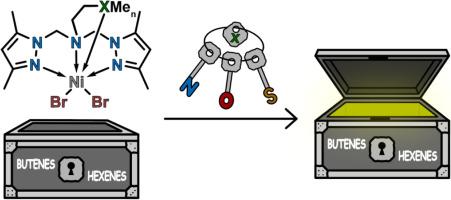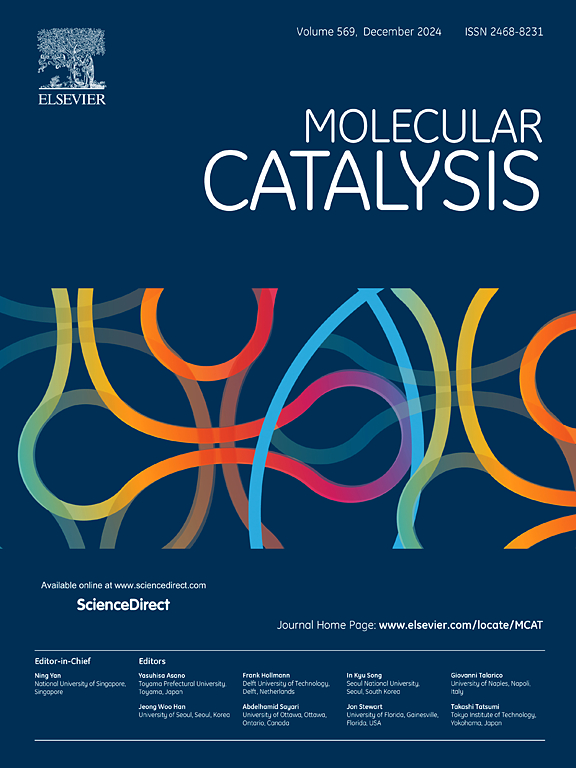含三足吡唑配体和附加给体原子稳定的Ni (II)配合物在乙烯低聚化催化中的应用
IF 4.9
2区 化学
Q2 CHEMISTRY, PHYSICAL
引用次数: 0
摘要
在本工作中,合成了几种由四齿NNNX和三齿NNN吡唑化合物连接的二溴镍配合物,并详细比较了它们作为乙烯低聚化的预催化剂。所有镍配合物(二乙基氯化铝或倍半氯化乙基铝)经DEAC或EASC活化后,均表现出中等活性(110 ~ 1100 kgPE/(molNi h)),主要生成短链烯烃(C4和C6)。在三齿nnn3,5 -二甲基吡唑配体上引入额外的供体原子(X),导致300 eq激活的镍(II)配合物序列的催化活性增加。去加重器件NNN & lt; & lt; NNNN & lt; NNNO & lt; & lt; NNN (55 & lt; & lt; 225 & lt; 280 & lt; & lt; 505 kgPE / (molNi h))配体。对于附加氮供体(X = N)的二溴镍(II)配合物,确定最佳Al/Ni比为75 eq.(1010和250 kgPE/(molNi h),分别由DEAC和EASC激活)。在这些条件下,还测试了带有四齿NNNN配体的非取代和4 -溴-3,5-二甲基吡唑环的配合物。后一种配合物的结构通过x射线衍射确定;结果表明,所有四个氮原子都与金属配位并形成三个五元螯合环。本文章由计算机程序翻译,如有差异,请以英文原文为准。

Ni (II) complexes stabilized by tripodal pyrazole-containing ligands with additional donor atoms in the catalysis of the ethylene oligomerization
In the present work, several dibromonickel (II) complexes ligated by tetradentate NNNX and tridentate NNN pyrazole-containing compounds were synthesized and compared in detail as precatalysts for ethylene oligomerization. All nickel complexes, after activation by DEAC or EASC (diethylaluminium chloride or ethylaluminium sesquichloride), showed moderate activity (110 to 1100 kgPE/(molNi h)), producing predominantly short-chain olefins (C4 and C6). The introduction of additional donor atoms (X) to the tridentate NNN 3,5-dimethylpyrazole-containing ligand leads to an increase in catalytic activity in the sequence of the nickel (II) complexes activated by 300 eq. DEAC with NNN << NNNN < NNNO << NNNS (55 << 225 < 280 << 505 kgPE/(molNi h)) ligands. For the dibromonickel (II) complex with an additional nitrogen donor (X = N), the optimal Al/Ni ratio was established as 75 eq. (1010 and 250 kgPE/(molNi h), activated by DEAC and EASC, respectively). The complexes bearing tetradentate NNNN ligands with unsubstituted and 4‑bromo-3,5-dimethylpyrazole rings were also tested under these conditions. The structure of the latter complex was established by X-ray diffraction; it is shown that all four nitrogen atoms coordinate with the metal and form three five-membered chelate cycles.
求助全文
通过发布文献求助,成功后即可免费获取论文全文。
去求助
来源期刊

Molecular Catalysis
Chemical Engineering-Process Chemistry and Technology
CiteScore
6.90
自引率
10.90%
发文量
700
审稿时长
40 days
期刊介绍:
Molecular Catalysis publishes full papers that are original, rigorous, and scholarly contributions examining the molecular and atomic aspects of catalytic activation and reaction mechanisms. The fields covered are:
Heterogeneous catalysis including immobilized molecular catalysts
Homogeneous catalysis including organocatalysis, organometallic catalysis and biocatalysis
Photo- and electrochemistry
Theoretical aspects of catalysis analyzed by computational methods
 求助内容:
求助内容: 应助结果提醒方式:
应助结果提醒方式:


